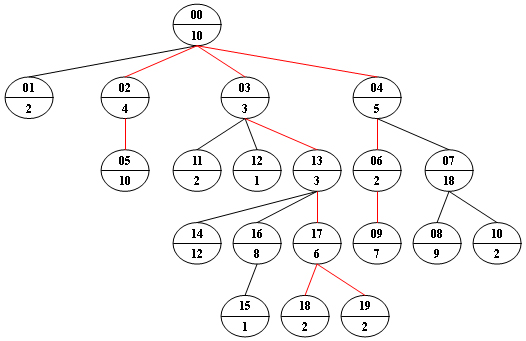Given a non-empty tree with root R, and with weight Wi assigned to each tree node Ti. The weight of a path from R to L is defined to be the sum of the weights of all the nodes along the path from R to any leaf node L.
Now given any weighted tree, you are supposed to find all the paths with their weights equal to a given number. For example, let's consider the tree showed in the following figure: for each node, the upper number is the node ID which is a two-digit number, and the lower number is the weight of that node. Suppose that the given number is 24, then there exists 4 different paths which have the same given weight: {10 5 2 7}, {10 4 10}, {10 3 3 6 2} and {10 3 3 6 2}, which correspond to the red edges in the figure.

Input Specification:
Each input file contains one test case. Each case starts with a line containing 0<N≤100, the number of nodes in a tree, M (<N), the number of non-leaf nodes, and 0<S<230, the given weight number. The next line contains N positive numbers where Wi (<1000) corresponds to the tree node Ti. Then M lines follow, each in the format:
ID K ID[1] ID[2] ... ID[K]
where ID is a two-digit number representing a given non-leaf node, K is the number of its children, followed by a sequence of two-digit ID's of its children. For the sake of simplicity, let us fix the root ID to be 00.
Output Specification:
For each test case, print all the paths with weight S in non-increasing order. Each path occupies a line with printed weights from the root to the leaf in order. All the numbers must be separated by a space with no extra space at the end of the line.
Note: sequence {A1,A2,⋯,An} is said to be greater than sequence {B1,B2,⋯,Bm} if there exists 1≤k<min{n,m} such that Ai=Bi for i=1,⋯,k, and Ak+1>Bk+1.
Sample Input:
20 9 24
10 2 4 3 5 10 2 18 9 7 2 2 1 3 12 1 8 6 2 2
00 4 01 02 03 04
02 1 05
04 2 06 07
03 3 11 12 13
06 1 09
07 2 08 10
16 1 15
13 3 14 16 17
17 2 18 19
Sample Output:
10 5 2 7
10 4 10
10 3 3 6 2
10 3 3 6 2代码:
#include<iostream>
#include<stack>
#include<vector>
#include<queue>
#include<algorithm>
using namespace std;
stack<int> St;
int N,M,S,weight=0,count1=0;
vector<int> path[110];
struct Node
{
int ID;//节点ID
int weight;//结点权值
vector<int> child;//结点的孩子ID
}node[110];
bool cmp(vector<int >a,vector<int > b)
{
for(int i=a.size()-1,j=b.size()-1;i>=0&&j>=0;i--,j--)
if(a[i]!=b[j])
return a[i]>b[j];
return a[0]>b[0];
}
void memo()
{
int temp[100],num,len=0;
while(!St.empty())
{
num=St.top();
temp[len++]=num;
St.pop();
path[count1].push_back(node[num].weight);
}
for(int i=path[count1].size()-1;i>=0;i--)
St.push(temp[i]);
count1++;
}
void DFS(int root)
{
St.push(root);
weight+=node[root].weight;
if(node[root].child.size()==0&&weight==S)
memo();
else if(weight<S)
{
for(int i=0;i<node[root].child.size();i++)
DFS(node[root].child[i]);
}
int temp=St.top();
St.pop();
weight-=node[temp].weight;
}
void print(int num)
{
for(int i=path[num].size()-1;i>0;i--)
printf("%d ",path[num][i]);
printf("%d\n",path[num][0]);
}
int main()
{
scanf("%d%d%d",&N,&M,&S);
for(int i=0;i<N;i++)
{
scanf("%d",&node[i].weight);//输入每个结点的权值
node[i].ID=i;
}
for(int i=0;i<M;i++)
{
int k,ID,child;
scanf("%d%d",&ID,&k);
for(int j=0;j<k;j++)
{
scanf("%d",&child);
node[ID].child.push_back(child);
}
}
DFS(0);
sort(path,path+count1,cmp);
for(int i=0;i<count1;i++)
print(i);
return 0;
}






















 209
209











 被折叠的 条评论
为什么被折叠?
被折叠的 条评论
为什么被折叠?








